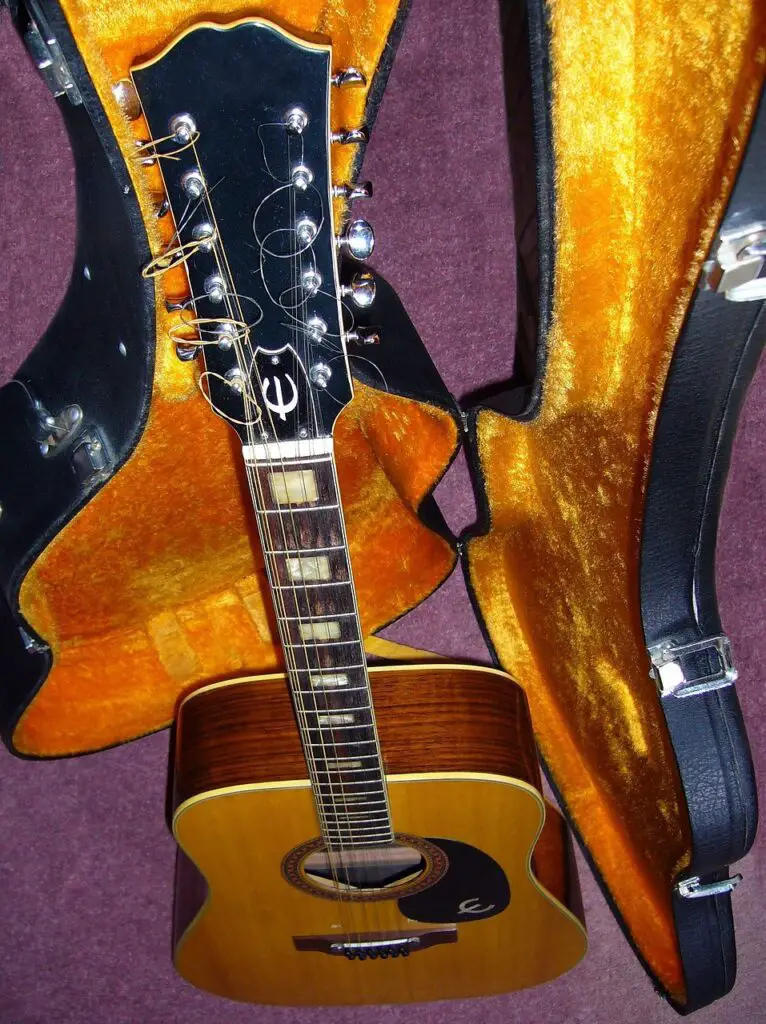A 12-string guitar is a unique instrument that produces a rich, full sound. However, tuning a 12-string guitar can be a bit more challenging than tuning a standard 6-string guitar. If you’re new to playing a 12-string guitar, it’s important to learn how to tune it properly to get the best sound possible.
There are different ways to tune a 12-string guitar, and it can be confusing to know which method to use. Some people prefer to tune a 12-string guitar a half-step down, while others prefer to tune it to standard tuning.
The tuning process can also vary depending on the type of music you’re playing. Whether you’re a beginner or an experienced player, learning how to tune a 12-string guitar is an essential skill that can take your playing to the next level.
Table of Contents
- Understanding the 12-String Guitar
- Tuning Basics
- Tuning Methods
- Common Tuning Issues
- Final Thoughts on Tuning a 12-String Guitar

Understanding the 12-String Guitar
The 12-string guitar is a unique instrument that produces a rich, full sound that can be heard in many different genres of music. It has six pairs of strings, with each pair tuned to the same note, but with one string being an octave higher than the other. This creates a chorus-like effect that is distinct to the 12-string guitar.
Because of the additional strings, the 12-string guitar can be more challenging to play and tune than a standard six-string guitar. It requires more precision and attention to detail to ensure that each string is in tune and producing the desired sound.
One of the most important things to understand about the 12-string guitar is that it is not simply a six-string guitar with extra strings. The additional strings require a different approach to playing and tuning, and it can take some time to get used to the unique sound and feel of the instrument.
It’s also worth noting that the tuning of a 12-string guitar can vary depending on the player’s preferences and the style of music being played. Some players prefer to tune the guitar a half-step down to make it easier to play, while others prefer to tune it to standard tuning.
It’s important to experiment and find the tuning that works best for you and your playing style.
Tuning Basics
Before you start tuning your 12-string guitar, it is important to understand the basics of tuning. The standard tuning for a 12-string guitar is E2, E2, A2, A2, D3, D3, G3, G3, B3, B3, E4, E4. This means that the two lowest strings (E2) are tuned to the same note, as are the two highest strings (E4). The remaining strings are tuned in pairs, one octave apart.
When tuning your guitar, it is important to have a good tuner. You can use a clip-on tuner or a tuner app on your phone. Make sure that your tuner is calibrated to A440, which is the standard tuning pitch. You can also use a piano or another instrument that is already in tune to help you tune your guitar.
When tuning your guitar, start with the lowest string (E2) and work your way up to the highest string (E4). Tune each string in pairs, one octave apart. For example, tune the two E2 strings first, then the two A2 strings, and so on. Use your tuner to match the pitch of each string to the correct note.
It is important to tune your guitar regularly to keep it sounding its best. If your guitar is out of tune, it will not sound good and it will be difficult to play. With a little practice, you can quickly learn how to tune your 12-string guitar and keep it sounding great.
Tuning Methods
There are several methods to tune a 12-string guitar. Some of the most common methods include:
- Standard Tuning: This is the most common tuning method for a 12-string guitar. The tuning is E-A-D-G-B-E for the six strings, and then the same tuning for the six higher octave strings.
- DADGAD Tuning: This tuning method is popular among folk and Celtic guitarists. The tuning is D-A-D-G-A-D for the six strings, and then the same tuning for the six higher octave strings.
- Open D Tuning: This tuning method is popular among slide guitarists. The tuning is D-A-D-F#-A-D for the six strings, and then the same tuning for the six higher octave strings.
- Drop D Tuning: This tuning method is popular among rock and metal guitarists. The tuning is D-A-D-G-B-E for the six strings, and then the same tuning for the six higher octave strings.
Regardless of the tuning method, it’s important to tune the guitar in a way that produces a balanced sound. This means making sure that each string is in tune with the others, and that the guitar is in tune with itself.
One way to achieve this is by using a guitar tuner. Tuners are available in a variety of styles, including clip-on tuners and pedal tuners. Some tuners even have the ability to tune multiple strings at once, making the process faster and more efficient.
Another way to tune a 12-string guitar is by using harmonics. This involves lightly touching the string at the 12th fret and plucking the string to produce a harmonic. By comparing the harmonic to the sound of the same note played on another string, you can adjust the tuning until they match.
Regardless of the method you choose, it’s important to take your time and make small adjustments to the tuning as needed. With practice, you’ll be able to tune your 12-string guitar quickly and accurately.
Common Tuning Issues
While tuning a 12-string guitar may seem like a straightforward process, there are some common issues that players may encounter. Here are some of the most common tuning issues and how to address them:
1. Intonation problems: Intonation refers to the accuracy of each note on the fretboard. If your guitar has intonation problems, it means that some notes may sound out of tune even if the open strings are perfectly in tune. This can be caused by a variety of factors, such as the guitar’s setup, the strings’ age, or the player’s technique. To address intonation problems, you may need to adjust the guitar’s bridge or saddle, or replace the strings.
2. String slippage: When tuning a 12-string guitar, it’s important to make sure that each string is securely in place. However, some strings may slip out of tune, especially if they’re new or if the guitar has been recently restrung. To prevent string slippage, make sure that each string is properly seated in the tuning peg and that the peg is tightened enough to hold the string in place.
3. Uneven tuning: One of the biggest challenges of tuning a 12-string guitar is achieving even tuning across all strings. This can be especially difficult if you’re using alternate tunings or if your guitar has a non-standard scale length. To address uneven tuning, you may need to adjust the tension on each string individually or use a tuner that allows you to tune each string separately.
4. Temperature and humidity changes: Changes in temperature and humidity can affect the tuning stability of your guitar. For example, if you’re playing in a cold room, the strings may contract and become sharper in pitch. Similarly, if you’re playing in a hot and humid environment, the strings may expand and become flatter in pitch. To address temperature and humidity changes, try to keep your guitar in a stable environment and tune it regularly to compensate for any changes in pitch.
Final Thoughts on Tuning a 12-String Guitar
Tuning a 12-string guitar may seem daunting at first, but with a little practice and patience, it can become second nature. Remember that the strings come in pairs, and tune the lower four pairs an octave higher than normal tuning, while tuning the higher two pairs the same as normal.
There are many resources available to help you with tuning your 12-string guitars, such as online guides and videos. Always use a chromatic tuner to ensure your guitar is perfectly tuned, and consider investing in a good-quality tuner if you plan on playing your 12-string guitar regularly.
It’s also important to remember that tuning is just the first step in playing your 12-string guitar. Don’t be afraid to experiment with different tunings and techniques to find the sound that works best for you. With a little creativity and practice, you can create beautiful music on your 12-string guitar.
- Review of the ALABS IRON MINI-WL: A Powerhouse Wireless Microphone - October 4, 2023
- What is a Saturator in Music Production: A Brief Explanation - May 11, 2023
- What Are Rotary DJ Mixers? An Overview - May 11, 2023
SoundStudiomagic.com is a participant in the Amazon Services LLC Associates Program, an affiliate advertising program designed to provide a means for sites to earn advertising fees by advertising and linking to Amazon.com. We also participate in other affiliate programs which compensate us for referring traffic.

